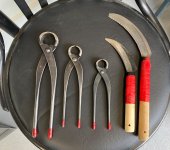I would avoid high-carbon steel for root cutting, unless you clean it after every few snips and sharpen it once a day. Abrasive and wet materials are brutal on this type of steel. You can use an old beater pair, but using dull scissors is no fun, even for rough work.
Stainless steel makes a lot more sense. Firstly, it will resist rust much better, so you don’t have to baby it if it gets a little wet. Secondly, the alloys added to stainless steels make them more abrasion-resistant, which usually helps with edge retention when cutting sandy or dirty material. Not all stainless steel is created equally, though. Tian makes some respectable tools in a few different quality grades, but generally equivalent to 420 and 440 steel. I have a branch and root cutter in the lowest grade Tian stainless. They are good but not great, but honestly, for the price and being made in China, they exceeded my expectations considerably.
You can go up from there to Hitachi ginsan aka silver paper steel, similar to their high carbon steels (white and blue) but with additional alloys to resist rusting. Most people will tell you this is one of the nicest to sharpen stainless steels out there, but that generally means edge retention will suffer too. Anyway, if you want a stainless steel that feels like high-carbon on your whetstones, this is it. I’m not sure if there are any easy-to-find brands sold in the US, but it’s not too hard to find ginsan bonsai tools if you buy direct from Japan (Yahoo auctions via Buyee etc).
You can also find Hitachi SLD (the Japanese version of D2 steel). Compared to ginsan, SLD is more abrasion-resistant but less rust-resistant (sometimes called semi-stainless). So it should hold an edge better but be more difficult to sharpen compared to ginsan. SLD is a very reasonable choice for root work, and it’s easy to find in the US on Amazon from wholesaler brands Wazakura and Kakuri. I’ve got a pair of Wazakura SLD scissors that I use for root trimming all the time. They work well, don’t rust very much (just cleaned some light surface rust off and oiled them tonight), and aren’t that much more difficult to sharpen than my high-carbon steels. They come with the added benefit that I have to clean the rust off and sharpen them much less, so the sharpening thing is moot in my view.
I’ve seen A8 (aka AUS-8) stainless from Kikuwa as well, but A8 isn’t a terribly impressive stainless steel, and for the pric,e I would get the Tian cutters instead.
Now, if you really want something that will cut roots and stay sharp, it’s some form of high-speed steel. This seems to be very difficult to find in Japanese-made cutting tools, though. I’ve only found one or two examples in ikebana scissors. That said, you might be able to find HSS scissors for some other purpose that works well for root trimming. Another user mentioned that he uses HSS fly-tying scissors.
In any case, I wouldn't subject my high-carbon steel tools to the abuse that my stainless steel tools get, so that would be my recommendation, unless you get lucky and can find a pair of HSS scissors.








